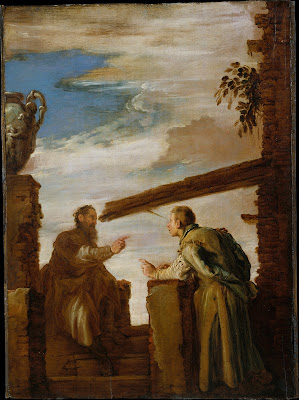Last summer I had another essay accepted by The National Catholic Reporter. I wrote it primarily to convince myself to have more patience with anti-vaxxers, something that is almost exponentially more difficult to do several months later. You can find the full essay (1200 words) here.
The essay discusses what the Gospel of Luke calls a parable--the Mote and Beam--and Domenico Fett's awesome painting of it (above). Along the way, I use Howard Thurman's "three Hounds of Hell," which I think is very helpful in understanding what motivates those who intentionally lie about vaccines, masks, and other mitigation efforts.
Here's a sample:
Jesus' admonitions are often difficult to implement, and the task is especially arduous when applied during a pandemic that is prolonged by people hesitant or even adamant about not taking simple actions to protect themselves and their neighbors. It seems that the "beams" are in their eyes, not ours, and that they are blind to both the danger and the solutions — and maddeningly so to the rest of us.
In addition, some influential voices — for fame, power and/or profit — deliberately mislead others about actions they should take to protect themselves and their neighbors, such as convincing people that the COVID-19 vaccines are unnecessary, or harmful, or a "personal choice" that does not affect others.
In such cases, it seems clear why Jesus prefaces the mote/beam parable in Luke with the parable about the blind leading the blind, with them all falling into a pit. Disaster is sure to follow, just as Jesus warned.
The arguments against masks, social distancing and vaccines are scientifically false, so their opponents are in error, sometimes tragically so. To be clear, Jesus' admonition not to "judge" other human beings in this section of Luke (6:37) does not mean that we should avoid correcting such erroneous beliefs and behaviors; it means instead that we should not judge in a condemnatory way (as noted in the same verse) and that our critiques should be merciful, generous, loving and intended to be redemptive, all of which are included in a humble acknowledgement of our own failings — noting the beams in our own eyes.
I don’t know if I’d say the same thing at this stage of the pandemic, but maybe I should:
https://www.ncronline.org/news/coronavirus/mote-and-beam-gives-insight-covid-19-debates





No comments:
Post a Comment